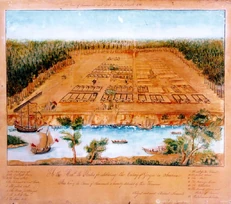
Founding of Savannah.
Georgia was the southernmost of the thirteen British colonies that engaged in the North American Rebellion. It was incorporated into the Southern Confederation of the Confederation of North America by the Britannic Design. Greatly expanded during the Trans-Oceanic War by the inclusion of Spanish Florida and the city of New Orleans, Georgia is now the S.C.'s largest and most important province. Its capital is Savannah and its largest city is New Orleans.
Georgia is the youngest of the original thirteen colonies, having been founded, along with the capital city of Savannah, on 12 February 1733. Largely Loyalist like the other Southern colonies apart from Virginia, Georgia escaped most of the organized fighting of the Rebellion. Georgian forces were central in the successful campaigns against Spain in the Trans-Oceanic War of the late 1790s, capturing all of Spanish Florida (and annexing it without asking permission of Britain or the rest of the C.N.A.), and leading the S.C. land forces for the combined operation against New Orleans. After the war, the invention of the cotton gin led to a rapid increase in cotton cultivation, which replaced tobacco as the S.C.'s principal cash crop, leading to an expansion of slavery and great prosperity for the new central and western areas of the province. During the Era of Harmonious Relations in the 1820s and 1830s vast plantations were established in Georgia that served as the Southern counterparts to McGregorization in the Northern Confederation. The social scene in the western Georgian city of Cornwallis rivalled that of the older Southern cities of Charleston, South Carolina and Norfolk, Virginia.
John Calhoun of Georgia, who became both the governor of the province and governor-general of the S.C. in 1833, was along with Willie Lloyd the dominant figure in the confederation's politics in the period leading up to the Second Britannic Design. He opposed Lloyd's manumission plan, but was one of the founders of the national Liberal Party and (along with Winfield Scott and Henry Gilpin) proposed the revisions to the Design that created the C.N.A. as a unitary nation. However, plans for a railroad spur connecting the city of St. Augustine with the New York, Michigan City, and Pitt Railroad were put on hold with the coming of war with the United States of Mexico in 1845. During the Rocky Mountain War, Georgian forces under Colonel Martin Washington crossed the Mississippi into the Mexican state of Jefferson, but were eventually repelled, leaving the border between the two nations unchanged.
In the middle of the century, industrialization changed the face of the province, particularly in the steel-producing region of the Tennessee Valley (including the city of New Birmingham). Georgia University became one of the leading institutions of higher learning in the C.N.A. and remains so today.
John Runk of Georgia, an admirer of Calhoun, unsuccessfully sought the Liberal nomination for Governor-General in 1878, losing to John McDowell at the convention. When McDowell took office, one of his chief concerns was the potential threat to Georgia from Mexican naval activity in the Caribbean Sea.
